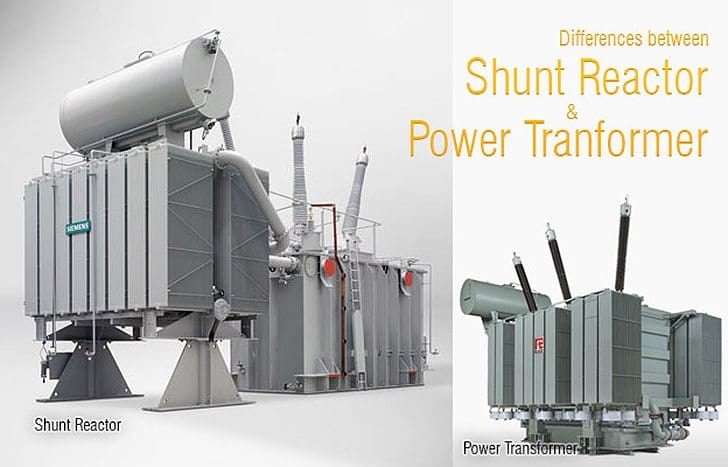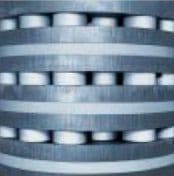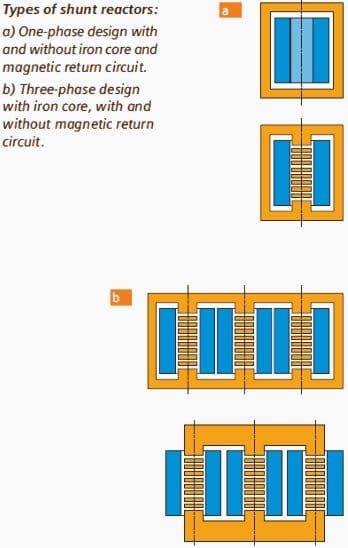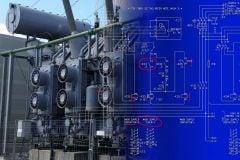Main Differences
Shunt Reactor and Transformer both appear similar in construction. Reactors are also often equipped with Fans for cooling similar to Power Transformers.
However, there are major differences between the two. While a Power Transformer is designed for efficient power transfer from one voltage system to another, a shunt reactor is intended only to consume reactive VArs (or in other words it can be stated as to produce lagging VArs).

Thus, there are more than one winding on a Power Transformer with magnetic core which carry the mutual flux between the two. In reactor there is just one winding. The core is not therefore meant only to provide a low reluctance path for flux of that winding to increase the Inductance.
In case of a Power Transformer, primary Ampere-Turns (AT) is sum of exciting AT and secondary AT. AT loss (in winding resistance, eddy loss and hysteric loss) is kept to as minimum as possible. Exciting AT is small compared with the secondary AT. Rated current is based on the load transfer requirement.

Magnetizing current is small and is negligible value when compared with the secondary rated current. Further, since mutual flux is main flux which results in transformation, leakage flux is kept small and will be based on fault current limitation.
In case of a Shunt Reactor due to absence of other windings, all primary AT is equal to the exciting AT. Similar to a Power Transformer, loss in AT (in winding resistance, eddy current and hysteresis) are also kept to minimum by design. Magnetizing AT is major component of a Shunt Reactor. Reactor magnetizing current is its rated current.
Since a Shunt Reactor magnetizing current is large, if it is designed with Iron alone as a Power Transformer, there will be large hysteresis loss. Air gaps in Iron core are provided in a Shunt Reactor to reduce this loss and to minimize the remanent flux in the core.
Thus a Shunt Reactor may also be constructed without iron (air-core).
Dry type Reactors are constructed as single phase units and are thus arranged in a fashion to minimize stray magnetic field on surrounding (in the absence of metallic shielding). When such an arrangement is difficult, some form of magnetic shielding is required and designed with care to minimize eddy current loss and arcing at any joints within the metallic loops. One of the advantages of dry type reactor is absence of inrush current.
Oil immersed reactors can be core-less or with gapped iron core. These are either single phase or three phase design with or without fan cooling. These are installed within tanks which hold oil & act as metallic magnetic shields.
In some cases, a Shunt Reactor may have additional small capacity winding which can provide power for small station power loads. Since Shunt Reactor rating is normally based on MVAr rating, this added station load VA shall be accounted for in designing the Reactor for such applications.

Shunt reactors are used in high voltage systems to compensate for the capacitive generation of long overhead lines or extended cable networks.
The reasons for using shunt reactors are mainly two
The first reason is to limit the overvoltages and the second reason is to limit the transfer of reactive power in the network. If the reactive power transfer is minimized i. e. the reactive power is balanced in the different part of the networks, a higher level of active power can be transferred in the network.
Voltage increase in a system due to the capacitive generation is:
ΔU(%) = QC x 100 / Ssh.c
where:
Qc is the capacitive input of reactive power to the network
Ssh.c is the short circuit power of the network
With increasing short circuit power of the network the voltage increase will be lower and the need of compensation to limit over-voltages will be less accentuated.
Reactors to achieve reactive power balance in the different part of the network are most needed in heavy loaded networks where new lines cannot be built because of environmental reasons. Reactors for this purpose mostly are thyristor controlled in order to adapt fast to the reactive power required.
Especially in industrial areas with arc furnaces the reactive power demand is fluctuating between each half cycle.
- Thyristor controlled reactors (TCR) and
- Thyristor switched capacitor banks (TSC).
Four leg reactors also can be used for extinction of the secondary are at single-phase reclosing in long transmission lines. Since there always is a capacitive coupling between phases, this capacitance will give a current keeping the are burning, a secondary arc.
By adding one single-phase reactor in the neutral the secondary arc can be extinguished and the single-phase auto-reclosing successful.
Resource: Shunt Reactors and Shunt Reactor Protection – S.R. Javed Ahmed











R/Sir, I have 6.6kv ,31.5micro farad 3 nos. (1450kvar) capacitor connected per phase another point connect with reactor n reactor end point is star contact and it’s unearthed. I would like to to earth it for ref protection.is this correct or wrong method. I will use CT in earth strip for ref protection relay but I have daubt that modification can be happened nonsense tripping. Actually I am not sure so I am discussing please
Dear Engineer brother, you have provided fruitful electrical engineering information with technically proved information as a ready recon-er, which are very needed in an emergency situation. Keep it up and provide other information in the electrical field.
Thanks and regard.
My request is : can you guys help about IBT transformer (lecture notes).
Regards
Greetings Mr. Edvard Csanyi. Thank you for such a concise and clear article for difference between power transformers and shunt reactors. Can you give a brief detail about the protection system for shunt reactor system?
knowing a reactor with inductance L and DCR has a time constant L/DCR what is the highest Q ratio that is practical or safe? As I see it, all DC batteries are low Q underdamped Supercaps and Reactors are low Q chokes. comments?
Dear sir:
Please your assistance. Typically shunt reactors are wye connected to earth. Some engineers when specify reactors ask for the zero sequence impedance from the manufacturer. However no secondary windings are present on reactors so zero sequence currents cannot be exist because they are not compensated (standard delta- wye or wye- wye transformers allow to flow zero sequence currents when stars are earthed). Is it possible to get the zero sequence impedance?
Thanks in advance and regards
Dear Edvard
The article is quite informarive and useful . i have one query
can we connect 30 MVAR REACTOR on 60 MVA Transformer
Will it not consume most of the transformer power .
ur reply is awaited
thanks
Prakash
how to check the oil test in shun reactor
We use 33kV Outdoor Metal Enclosed Capacitor Banks, primarily of 2 types of ratings, namely 5MVAR and 20MVAR in our distribution networks (5 stages of 1MVAR each and 5 stages of 4MVAR each – respectively). A typical stage circuit comprises of:
HRC Fuses + Stage CB + Overload CTs + Inrush Reactors + the Capacitor Banks connected in double-star configuration.
Can you please advise, as to how does one arrive at the numerical value of the inrush reactors? Please throw some light.
Can you please provide circuit diagram of shunt reactor connected to transmission line
I need Reactor shunt, what your contact person in Indonesian,thanks
Dear Sir,
Hello.
Let me introduce myself,My name is Hardik Shah & We are India based company and manufacturing all type of Electric Transformer products.
As we are top manufacturers of the shunt reactors Oil-Immersed and Air-Core Dry type,I want to expand my business in Indonesia.
We are top exporter from India for the same product in North America,Europe,Asia-Pacific,South America,Middle east,Africa.
If you feel any query,please revert without hesitation,we surly workout.
My website is : http://www.ntplindia.co.in
With Best regards,
Hardik Shah
Director at NTPL.
+91 99250 33009
Available on WhatsApp.
Dear Sir,
I want to know weather Power transformer can be made have a tertiary winding for reactor? If so can I have little details please.
EEP is doing a great job , by publishing technical articles in a nutshell which provides a summary and giving a feeling that we have got in our mind a clear idea about the matter which is explained in the reffered book/s.
Keep going and we are expecting more and more
Mr.Edvard
Congrats for this wonderful job
loved this portal it has lots of worthy information i appreciate it and if you want any help i am ready to help you. hats off to your effort
Thanks Surendranath! You can help in any way, from suggestions to writing technical articles. One thing is sure – 25K+ members will be very gratefull to you!